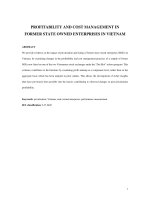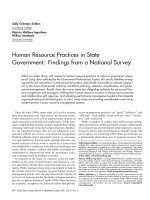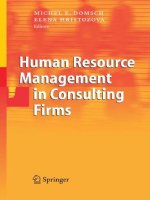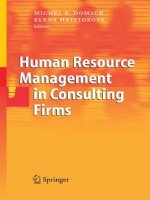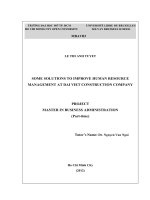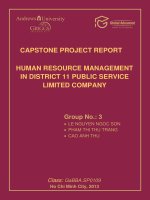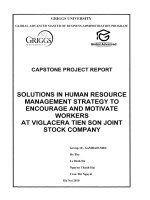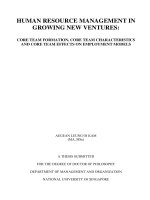To improve human resource management in state owned enterprises, especially in making steel industry
Bạn đang xem bản rút gọn của tài liệu. Xem và tải ngay bản đầy đủ của tài liệu tại đây (610.34 KB, 95 trang )
ĐẠI HỌC MỞ TP HCM
UNIVERSITE OUVERTE DE HCMV
UNIVERSITÉ LIBRE DE BRUXELLES
SOLVAY BUSINESS SCHOOL
CHƯƠNG TRÌNH THẠC SỸ QUẢN TRỊ (MMVCFB6)
PROGRAMME DE MAITRISE EN MANAGEMENT VIETNAM COMMUNAUTE FRANCAISE DE BELGIQUE
N
N
G
G
U
U
Y
Y
E
E
Ã
Ã
N
N
T
T
H
H
Ị
Ị
T
T
H
H
U
U
Û
Û
Y
Y
T
T
I
I
E
E
Â
Â
N
N
T
T
O
O
I
I
M
M
P
P
R
R
O
O
V
V
E
E
H
H
U
U
M
M
A
A
N
N
R
R
E
E
S
S
O
O
U
U
R
R
C
C
E
E
M
M
A
A
N
N
A
A
G
G
E
E
M
M
E
E
N
N
T
T
I
I
N
N
S
S
T
T
A
A
T
T
E
E
O
O
W
W
N
N
E
E
D
D
E
E
N
N
T
T
E
E
R
R
P
P
R
R
I
I
S
S
E
E
S
S
,
,
E
E
S
S
P
P
E
E
C
C
I
I
A
A
L
L
L
L
Y
Y
I
I
N
N
M
M
A
A
K
K
I
I
N
N
G
G
S
S
T
T
E
E
E
E
L
L
I
I
N
N
D
D
U
U
S
S
T
T
R
R
Y
Y
M
M
A
A
S
S
T
T
E
E
R
R
O
O
F
F
M
M
A
A
N
N
A
A
G
G
E
E
M
M
E
E
N
N
T
T
T
T
H
H
E
E
S
S
I
I
S
S
Supervisor:
Professor VŨ VIỆT HẰNG
Ho Chi Minh City, Vietnam
(2007)
GUARANTEE:
Tôi xin cam đoan đây là công trình nghiên cứu của
riêng tôi. Các số liệu và các kết quả được nêu trong
luận văn tốt nghiệp là hoàn toàn trung thực.
Nguyễn thò Thủy Tiên
1
ACKNOWLEDGEMENT
The author wishes to express her sincere thanks and appreciation to
Professor Vu Viet Hang for her precious guidance and suggestion
during this research study being carried out.
Special thanks go to Ho Chi Minh City Open University for its holding
this Master course in Management.
She much appreciates her professors’ and friends help during the
period of data collection, especially, Mr. Hung’s, Mr. Long’s, Mr.
Son’s, Mr. Dien’s, Mr. Vinh and many other friends’ great help in
collecting secondary data from Vietnam Steel Corporation and some
other enterprises in Steel Industry.
The author also would thank her family for its financial and spiritual
support during her course time.
5
Table of Contents
Chapter Title
Page
ACKNOWLEDGEMENT 1
SUPERVISOR’S COMMENTS 2
OPPONENT COMMITTEE’S COMMENTS 4
Table of Contents 5
List of Tables 7
List of Figures 8
INTRODUCTION 9
CHAPTER 1: LITERATURE REVIEWS
1.1 Organization Theories
1.2 Defining Human Resources Management
1.3 The Evolution of Human Resources Management
1.4 Environment of Organization
13
14
16
21
23
CHAPTER 2: THE ENVIRONMENT OF SOES IN VIETNAM STEEL
INDUSTRY
2.1 The History of Build-up and Development of Vietnam Steel
Industry
2.1.1 The History
2.1.2 The Organization Framework
2.1.3 Basic Information of Vietnam Steel Corporation
2.2 The Environmental factors in Organizational Performance in
Vietnam Steel Industry – public sector
2.2.1 External Environmental Factors
2.2.2 Internal Environmental Factors
2.2.3 The Outcomes of the Organization
2.2.4 The Matters VSC to deal with
2.2.5 The Trends of Development of VSC and the Challenges to the
Future
27
27
27
30
31
33
34
40
47
49
51
CHAPTER 3: STAFFING
3.1 Literature Review
52
52
6
3.2 Facts and Findings
3.2.1 Facts
3.2.2 Findings
3.3 Suggestions
53
53
55
60
CHAPTER 4: TRAINING AND DEVELOPMENT
4.1 Literature Review
4.1.1 The Training and Development components and relationship
to organization changes
4.1.2 Factors Influencing T&D
4.1.3 The T&D Processes
4.2 Facts and Findings
4.2.1 Facts
4.2.2 Findings
4.3 Suggestions
62
62
63
64
65
67
67
69
70
CHAPTER 5: COMPENSATION AND REWARDS
5.1 Literature Review
5.2 Facts and Findings
5.2.1 Facts
5.2.2 Findings
5.3 Suggestions
73
74
75
75
79
82
CHAPTER 6: SAFETY AND HEALTH
6.1 Literature Review
6.1.1 The Nature of Safety and Health
6.1.2 Roles of Safety and Health Management
6.1.3 The Focus of Safety Programs
6.1.4 Developing Safety Programs
6.2 Facts and Findings
6.3 Suggestions
84
84
84
86
88
89
90
91
CONCLUSION 92
REFERENCES 95
7
List of Tables
Table 2.1: Share of Steel Suppliers in the World 31
Table 2.2: COP of World Steel Producing Countries 33
Table 3.1: Level of schooling of the laborers in the whole VSC 54
Table 3.2: Comparing the level of schooling of the laborers, 2006 55
Table 3.3: Structures of personnel for rolling workshops of public
sector
55
Table 3.4: Structures of personnel for rolling workshops in different
sector
57
Table 5.1: Personnel, output, average income and wage/ton (2006) 79
Table 5.2: Typical payment score system used in a SOE’s melting
workshop since 1995 to 2006
80
Table 5.3: Quoted pay-sheet for workshops of a JV and a public firms 81
List of Boxes
Box 2.1: Eight criteria for analyzing quality of work life 37
8
List of Figures
Figure 1.1: Five circles model of organizational environment 15
Figure 1.2: Personnel versus HRM 20
Figure 1.3: Sectors of the general environment 25
Figure 2.1: Vietnam Steel Corporation framework 30
Figure 2.2: A model of Organization performance 34
Figure 2.3: Markets with globalization-competition 39
Figure 2.5: SWOT of Human Resources in Steel SOEs 50
Figure 4.1: Developing a training program 66
9
INTRODUCTION
The tenth congress/Plenum of Vietnamese Communist Party has stated the general
social-economic targets in period 2006 – 2010 are accelerating the nation’s
economic growth rate to get the crucial evolution in sustained development;
promoting the industrialization – modernization great undertaking and developing
the knowledge economy, the foundation to make Vietnam basically become an
industrial developed country by 2020. The Plenum has also pointed out their
principle missions: emancipating production resources; upgrading the quality and
competence of the competition of the economy; and accelerating economic growth
rate. Besides, it suggested turning the state economy to market-economy with
socialist orientation together with performing market rules, forming synchronously
all kinds of market and the institutional system; proactively integrating into the
world economy; expanding foreign economic cooperation together with enhancing
the independence and self-control capacity of the economy.
Recently, one of the most principle missions mentioned above has been completed
successfully. That is, Vietnam has become official member of World Trade
Organization since January 2007.
However, going into the international economic environment has exposed
endogenous challenging factors of the Vietnam economy. One of the main
challenges is the workforce, from the whole labor market to a certain sector, likely
not ready for the new phase. Considering Vietnam enterprises carefully, we can
find evidences that prove the challenge. What is resulting on low level of
competitive competence, on restrained ability in resources management, on
unstable quality of goods and services, and on high cost of goods sales, if it is not
the workforce with its low productivity? It bears also the blame for local
businesses’ losing their market share just in their own fields.
Moreover, affected by many crucial forces, thing would be broken at its utmost
weak point. On accomplishing the most principle mission, Vietnam economy
would taste some blows, so. One of the blows is the unexpected difficult stage that
some of public companies are now experiencing. Statistics says that in the year
1995, there was 9.2% labor-force working in public sector of economy, with the
contribution to the GDP was 40.2%. In the year 2004, the figures were 10% and
10
38.4% respectedly. Those numbers show that the relationship between number of
workers and the contribution of those workers to GDP has a contra-variation. The
situation would deteriorate in firms that operating in such traditional industries as
energy, coals and metallurgy with their own restricted competencies. Once more,
that is to say the cause is low productivity of the workforce.
Therefore, to the Vietnam economy, especially to the public sector, the matter
could be named the low level of productivity of the workforce.
What cause the low level of productivity of the workforce? Is the human resources
managed ineffectively, or even mismanaged? What are the measures to deal with
the matter to accomplish the mission of the state economy successfully?
There were many researches studying of problems related to the effectiveness of
human resources management and suggesting possible solutions. However, those
researches are in a wide scope, so the solutions given are truly general. That means,
those researches have not profoundly gone into a specific case to give reasonable
measures, true wanting, for a specific industry. How is the relationship that
mutually affect between employers, employees in managerial structure systems,
law systems, and the intervention of Labor Unions? How could an SOE exploit
effectively and efficiently its human resources? Which tools could be use to
strengthen the available labor force? Could the workforce get higher productivity,
and gain competitive advantages? The answers for these questions would be the
objectives of this research study.
To make the study more specific, applicable, the writer would narrow down the
scope of research to SOEs in making steel industry, a heavy industry that used to be
the main industry of Vietnamese economy in the period 1970s - 1980s. The objects
of the study are including the former SOEs, which are on the process of
capitalization recently.
Method applied in the research would base on recent theories in human resources
management, associate with relating Vietnamese law systems, to examine the real
situations to point out the solutions. To make it realistic, the research study would
use the statistic data from internal the Vietnam Steel Corporation, from Vietnam
Steel Institute.
11
The content of the research, excluding the introduction, conclusion and table of
referred materials, includes 6 chapters.
1) Chapter 1 is to review the theories that would be used to analyze the problem.
2) Chapter 2 would introduce the history of build-up and development the
Vietnamese Steel Industry, and describe the environment of the organization
with their trend of changing rapidly now on the viewpoint of modernist
theorists. Chapter 2 describes the environment of the organization with their
trend of changing rapidly now on the viewpoint of modernist theorists.
3) Chapter 3, 4, 5, 6 are to analyze the real human resources managerial situations
in the State Owned Sector of Vietnamese Steel Industry. The analysis based on
the theories of the Evolution of Personnel to Human Resources Management,
with approaching method from the Law aspect, the relationship between
employers and employees that intervened by Labor Unions. Each chapter
includes three sub-parts. The first one is to review theories of Evolution of
Personnel to Human Resources Management. The second part is to give the
facts and findings analysis of HRM in the object with its own statistic numbers.
The last one is to point out what the real cause that HRM is not effective, nor
efficient, and then to suggest some possible solutions.
4) The last chapter, the conclusion is to give the trends of development of the steel
industry, suggest certain measures to improve human resources management in
the state owned enterprises.
Being an employee in a factory in public sector for year, having the feeling of
responsibility for the development of the industry, I am to do the research seriously.
However, the study would have limitations.
First, it is the limitation in the scope of the study. The study concentrates into
analyzing human resource management of the SOEs, or former SOEs, in Steel
Industry only. Therefore, the suggestions or solutions given are not so general to
apply to all other industries.
Second, it is the preciseness of the data gathered. For the spirit of secret-keeping
regulations is getting chronic to each public employee, who is object of the study,
the data got by direct interviews would not reflex so exactly the reality. Besides, for
12
some reasons, the statistical reported data got from Vietnam Steel Corporation or
from VSI are somewhat puzzling. Moreover, the survey was performed at the
crucial and confusing moment, when the process of capitalization has been carrying
out in many factories in the industry. So, some data could be used as reference
only.
Third, due to the limited time, the research study would have its own limitations in
applying the theories to analyzing the reality, presenting the paper….
13
CHAPTER 1
LITERATURE REVIEWS
“Labor is the most important activity of a human being creating both material
products and social values. High labor productivity, quality and efficiency are
significant factors which determine the level of development of a country.”
“The Labor Code protects the right to work, benefits, and other rights of employees
and, at the same time, protects the legal rights and benefits of employers, thereby
creating conditions for harmonious, and stable labor relations, contributing to the
development of the creativity and talents of intellectual and manual workers and of
labor managers in order to achieve productivity, quality, and social advancement
in labor, production, and services, effective utilization and management of labor,
and contributing to industrialization and modernization of the country, for a
wealthy and strong country, and a fair and civilized society.”
(Labor Code of Socialist Republic of Vietnam,
2003)
Human resources management, a specific field of management, dealing with the
organization’s governance, is not a new subject to all business and service
organizations. No matter how large an organization is, its fundamental activities
pertaining to all employees, human resources, must be managed – and managed
effectively. From a positive standpoint, it is people, human resources, who create
organizations and make them survive and prosper. It is their efforts, talents, and
skills in using other resources, such as knowledge, materials, and energy; that result
in the creation of useful products and services. If they are neglected, or
mismanaged, the organization is unlikely to do well and, in fact, may fail.
Therefore, being a member of some organization, in deed, for our survival and
development, we do have to study the subject to have a better understanding of it,
to practice it more effectively. That is, we must be aware of the questions involved
in human resource management such as what the real nature of human resource
14
management is, what matters are central to human resources management, and how
to manage the resources properly to achieve the organization’s objectives.
Through the materials, we all know that human resources management is a broad
concept referring to the philosophy, policies, procedures, and practices used in
managing people throughout the organization. Besides, the globalization trend in
business in the new millennium has made the nature of human resources
management, consequently the role of HR people, more and more complicating.
The objective of the research study is to provide/recommend measures to exploit
more effectively and efficiently human resources in public sector of Steel Industry
in Vietnam. To understand how the human resources there are, the science of
organization and management would provide us theoretical method of approach.
The science has not developed properly in Vietnam, so we should have a look on
the global theories in this chapter. Then, we spend a little bit attention to the history
of build-up and development of the industry, and the recent context of the
organization’s environment, that would help us to address what model of the
organization is, what the matters it is confronting, and how to solve the problems in
following chapters.
1.1 ORGANIZATION THEORIES:
There are multiple perspectives of organization. Sometimes, the word
“organization” is to describe an entity when we are describing the place where
people work, a particular business enterprise or as a general term to describe
undertakings. Other times, it is also used to refer to a process describes how
something is done… Each perspective is related to the phenomenon, which an
organization theorist encounters with his perceptual equipment, and then
developed.
To go on with the research study, I would refer to the “Five Circles Model”, which
is introduced by Mary Jo Hatch in Organization Theory, Modern, Symbolic, and
Postmodern Perspective (Oxford, 1997). The model is to conceptualize an
organization as an interplay of technology, social structure, culture, and physical
structure embedded in and contributing to an environment. To depict these
15
relationships, it shows technology, social structure, and physical structure as
interconnected circles (or as spheres) surrounded and penetrated by an environment
that they simultaneously help to constitute.
Figure 1.1
The interconnections of the circles suggest that none of the concepts or theories is
complete itself; each shares some aspects with the others and it is the combination
of these different ways of understanding complex views of organization.
ENVIRONMENT
Culture
Social
structure
Physical
structure
Technology
ORG
Five circles model
(Marie Jo Hatch, 1997)
16
1.2 DEFINING HUMAN RESOURCES MANAGEMENT:
“Workforce, or human resources, create organizations and make them survive and
prosper. It is their efforts, talents, and skills in using other resources, such as
knowledge, materials, and energy; that result in the creation of useful products and
services. If human resources are neglected or mismanaged, the organization will
not do well, certainly in the long-run.”
Wendell L. French (1998)
It is simple to say that human resources management is a specific field of
management, dealing with the organization’s governance.
However, with such concepts of organization and human resources as mentioned
above, it’s not easy to define the term “human resource management” (HRM). In
their works of the HRM science, Derek Torrington, Laura Hall and Stephen Taylor
say: “On the one hand, the term is generically to describe the body of management
activities. In this use, HRM is, really, no more than a modern and supposedly
imposing name for what has long been labeled “personnel management”, namely
“HRM mark 1”, a generic term. On the other hand, the term is equally widely used
to denote a particular approach to the management of people, namely “HRM mark
2”, a distinctive one, which is clearly distinct from “personnel management”. Used
in this way, it suggests such a distinctive philosophy towards carrying out people-
oriented organizational activities that is held to serve the modern organization more
effectively than “traditional” personnel management”. We would go further to
these two meanings of human resource management.
1.2.1 HRM mark 1: The generic term
The first meaning of HRM is the systematic planning and management of a network
of fundamental organizational processes affecting and involving all organization
members: human resources planning, job and work design, job analysis, staffing,
training and development, performance appraisal and review, compensation and
reward, employee protection and representation, and organization improvement.
17
We can group those processes into five functional areas that are associated with
effective HRM: staffing, human resource development, compensation and benefits,
safety and health, and employee and labor relations. Those functions aim at key
objectives: staffing, performing, change-management, and administration, which
form the foundation of all HRM activities. Identifying the key objectives that HR
department seeks to achieve on behalf of organization, either singly or with the help
of other departments, is the best way to explain the role played by HR functions.
Staffing objectives:
Human resource managers are first concerned with ensuring, as far as is possible,
that the organization is appropriately staffed and is thus able to draw on the human
resources it needs. This involves designing organization structures, identifying
under what type of contract different groups of employees (or subcontractors) will
work, before recruiting, selecting and developing the people required to fill the
roles: the right people, with the right skills to provide their services when such
services are needed. There is a need to compete effectively in the employment
market by recruiting and retaining the best, affordable workforce that is available.
This involves developing employment packages that are sufficiently attractive to
maintain the required employee skills levels and, where necessary, disposing of
those judged no longer to have a role to play in the organization.
Performing objectives:
Once the required workforce is in place, human resource managers seek to ensure
that individuals are as well motivated and committed as possible so as to maximize
their performance targets. In many organizations, particularly where trade unions
play a significant role, human resource managers negotiate improved performance
with the workforce. The achievement of performance objectives also requires HR
specialists to assist in disciplining employees effectively and equitably, where
individual conduct and/or performance standards are unsatisfactory. Welfare
functions can also assist in achieving and maintaining high performance standards
by providing constructive assistance to people whose performance has fallen short
of their potential because of illness or difficult personal circumstances. Last but not
least, there is the range of employee involvement initiatives which are sponsored by
18
human resource functions as a means of raising levels of commitment and engaging
employees in the development of new ideas.
Change-management objectives:
A third set of core objectives in nearly every organization relates to the role played
by the human resource function in the effective management of change. For a good
proportion of organizations, change no longer comes along in readily defined
episodes precipitated by some external factor. Instead, it is endemic and well nigh
continuous, generated by a continual need to innovate as much as from definable
environmental pressures. Change comes from different forms. Sometimes it is
merely structural, requiring reorganization of activities or the introduction of new
people into particular roles. At other times, cultural change is sought; a more
general objective being the need to alter attitudes, philosophies or long-present
organizational norms in any of these scenarios the HR function can play a central
role. Key activities include the recruitment and/or development of people with the
necessary leadership skills to drive the change process, the employment of change
agents to encourage acceptance of change and the construction of reward systems
which underpin the change process. Timely and effective employee involvement is
crucial here too because “people support what they help to create”.
Administration objectives
The fourth type of objectives is less directly related to achieving competitive
advantage, but is no less necessary in the contemporary business environment. It is
essentially administrative in nature and is focused on underpinning the achievement
of the other forms of objectives. In part, it is simply carried out in order to facilitate
an organization’s smooth running. Hence, there is a need to maintain accurate and
comprehensive data on individual employees, a record of their achievement in
terms of performance, their attendance and training records, their terms and
conditions of employment and their personal details. However, there is also a legal
aspect to much more administrative activity, meaning that it is done because the
business is required by law to comply. Of particular significance is the requirement
that payment is administered professionally and lawfully, with itemized monthly
pay statements being provided for all employees. There is also the need to make
arrangements for the deduction of taxation and national insurance, for the payment
19
of pension fund contributions and to be on top of the complexities associated with
Statutory Sick Pay and Statutory Maternity Pay. Additional legal requirements
relate to the monitoring of health and safety systems and the issuing of contracts to
new employees. Accurate record keeping is central to ensuring compliance with a
variety of new legal obligations such as the National Minimum Wage and the
Working Time Regulations.
We would return to those later, when we go deeply to the researched case.
1.2.2 HRM mark 2: a distinctive approach to the management of people
The second meaning commonly accorded to the term “human resource
management”, denotes a particular way of carrying out the range of activities
discussed above. Under this definition, a “human resource management approach”
is something qualitatively different from a “personnel management approach”.
A particular theme in their work is the contention that personnel management is
essentially workforce centered, while HRM is resource centered (see figure 1.2).
That means, personnel specialists direct their efforts mainly at the organization’s
employees; finding and training them, arranging for them to be paid, explaining
management’s expectations, justifying management’s actions, satisfying
employees’ work-related needs, dealing with their problems and seeking to modify
management action that could produce an unwelcome employee response. The
people who work in the organization are the starting point, and they are a resource
that is relatively inflexible in comparison with other resources, like cash and
materials.
HRM, by contrast, is directed mainly at management needs for human resources
(not necessarily employees) to be provided and deployed. Demand rather than
supply is the focus of the activity. There is greater emphasis on planning,
monitoring and control, rather than mediation. Problem solving is undertaken with
other members of management on human resource issues rather than directly with
employees or their representatives. It is totally identified with management
interests, being a general management activity, and is relatively distant from the
workforce as a whole.
20
We note that while recognizing the differences, an alternative point of view
downplays the significance of a break between personnel and human resources
management. First, human resource management concentrates more on what is
done to managers rather than on what is done by managers to other employees.
Second, there is a more proactive role for line managers. Third, there is a top
management responsibility for managing culture.
Figure 1.2 Personnel versus HRM
Personnel management Human resource management
Time and planning
perspective
Short term, reactive, ad hoc,
marginal
Long term, proactive,
strategic, integrated
Psychological contract Compliance Commitment
Control systems External controls Self – control
Employee relations
perspective
Pluralist, collective, low trust Unitarist, individual, high
trust
Preferred
structures/systems
Bureaucratic/mechanistic,
centralized, formal defined
roles
Organic, devolved, flexible
roles
Roles Specialist/professional Largely integrated into line
management
Evaluation criteria Cost minimization Maximum utilization (human
asset accounting)
From this perspective, human resource management can simply be seen as the most
recent mutation in a long line of developments that have characterized personnel
management practice as it evolved during the last century. HRM is therefore the
latest new dimension to be added to a role, which has developed in different
directions at different stages in its history. There are six distinct stages in the
historical development of the personnel management function, that make-up the
evolution of personnel or human resource management.
21
1.3 THE EVOLUTION OF HUMAN RESOURCE MANAGEMENT
Along with the history and development of organization theories in the world,
human resource management has its own evolution. The evolution of HRM field, as
introduced in Human Resource Management (Derek Torrington, Laura Hall &
Stephen Taylor, Prentice Hall, 2002) can be divided into 6 main stages, as
followed.
Stage 1: the social reformer
The origins of personnel management was deriving from the work of social
reformers. Their criticisms of the free enterprise system and the hardship created by
the exploitation of workers by factory owners enabled the first personnel managers
to be appointed and provided the first frame of reference in which they worked.
Such concerns are not obsolete. There are still regular reports of employees being
exploited by employers flouting the law, and the problem of organizational distance
between decision makers and those putting decisions into practice remains a source
of alienation from work.
Stage 2: the acolyte of benevolence
In the late nineteenth and early twentieth centuries, some of larger employers with a
paternalistic outlook began to appoint welfare officers to manage a series of new
initiatives designed to make life less harsh for their employees. There were the
progressive schemes of unemployment benefit, sick pay and subsidized housing
provided by firms. While the motives were ostensibly charitable, there was and
remains a business as well as an ethical case for paying serious attention to the
welfare of employees. This is based on the contention that it improves commitment
on the part of staff and leads potential employees to compare the organization
favorably vis-à-vis competitors. The result is higher productivity, a longer-serving
workforce and a bigger pool of applicants for each job. It has also been argued that
a commitment to welfare reduces the scope for the development of adversarial
industrial relations. The more conspicuous welfare initiatives promoted by
employers today include pension schemes, childcare facilities and health-screening
programs.
22
Stage 3: the humane bureaucrat
This is the phase marked by the starting of a move away from a sole focus on
welfare issues towards the meeting of various other organizational objectives. In
the phase, personnel managers began to gain responsibilities in the areas of staffing,
training and organization design. They performed management and administration
processes more analytically, worked out organizational structures to deployed labor
with efforts to maximize efficiency. That the stage was also influenced by the
Human Relations School in seeking to ameliorate the potential for industrial
conflict and dehumanization present is to rigid an application of the scientific
management approaches. Then, the fostering of social relationships in the
workplace and employee morale thus became equally important objectives for
personnel professionals seeking to raise productivity levels.
Stage 4: the consensus negotiator
The stage of consensus negotiator is the stage personnel managers needed the skills
of bargaining. This was the period of full employment followed the Second World
War, and of growing forming union membership. Personnel specialists had to
manage the new collective institutions such as joint consultation committees, joint
production committees and suggestion schemes set up in order accommodate the
new realities, and employers were placed under a statutory duty to negotiate with
unions representing employees, while government encouraged the appointment of
personnel officers.
Stage 5: organization man
The late 1960s saw a switch in focus among personnel specialists, away from
dealing principally with the rank-and-file employee on behalf of management,
towards dealing with management itself and the integration of managerial activity.
This phase was characterized by the development of career paths and of
opportunities within organizations for personal growth. This too remains a concern
of personnel specialists today, with a significant portion of time and resources in
many organizations being devoted to the recruitment, development and retention of
an elite core of people with specialist expertise on whom the business depends for
its future.
23
Stage 6: the manpower analyst
The final stage prior to the advent of human resource management in the 1980s
involves personnel specialists developing the capacity to undertake the techniques
of manpower or workforce planning. This is, basically, a quantitative activity,
boosted by the advent of information technology, which involves forecasting the
likely need for employees with different skills in the future. According to Message
(1974) it comprises three main processes:
1. Assessing what manpower of what different grades, categories and skills
will be needed in the short and long term (i.e. manpower demand),
2. Deciding what manpower an organization is likely to have in the future,
based on current trends and anticipated external circumstances (i.e.
manpower supply),
3. Taking action to ensure that supply meets demand.
Manpower planning (now commonly referred to as human resource planning)
remains a task undertaken by some HR specialists. Increasingly however, the
unpredictability of some business environments has made accurate forecasting
difficult, leading to its abandonment as a formal management activity in a number
of organizations.
1.4 ENVIRONMENT OF ORGANIZATIONS
In modernist organization theories, the organizational environment is
conceptualized as an entity that lies outside the boundaries of the organization. It
influences organizational outcomes by imposing constraints and demanding
adaptation as the price of survival. The organization, for its part, faces uncertainty
about what the environment demands while it experiences dependence on the
multiple and various elements that comprise its environment. It is just the
dependence and uncertainty explain organizational structures and action in the
environment conceived by modernist organization theorists.
In modernist perspectives, organizational environments are typically defined by
their elements, which are sorted out by three most common ways into the inter-
24
organizational network, the general environment, and the international
environment.
The Inter-organizational Network consists of suppliers, customers, competitors,
unions, regulatory agencies, and special interests. A network analysis presents the
inter-organizational network as a complex web of relationships in which a group of
organizations is embedded. The network shows the relative positions of all
considered organizations, with the links representing channels through which
resources, information, opportunities, and influence flow. The network perspective
promotes sensitivity to the variety and complexity of interactions that sustain
organized activity within the environment.
The main challenge in performing a network analysis is determining a reasonable
boundary. The solution to defining network could alter the concept of the network,
unbalance the analysis, and the result is that information appears outside the
periphery of the construction of the network would be disregarded, or under
evaluated.
The General Environment is to analyze the more general forces at work in an
environment of organization. These forces will have an effect throughout the
network, so it is useful to appreciate fully the links between organization and its
environment. General environment includes different sectors: social, cultural, legal,
political, economic, technological, and physical (figure 2.1).
• Social sector of the environment is associated with class structure,
demographics, mobility patterns, life styles, and traditional social institutions
including educational system, religious practices, trades, and professions.
• Cultural sector revolves around issues such as history, traditions, expectations
for behavior, and the values of the society or the societies in which the
organization operates.
• Legal sector is defined by the constitutions and laws of the nations in which the
organization conducts its business, as well as legal practices in each of these
domains.
• Political sector is usually described in terms of the distribution and
concentration of power and the nature of political system in those areas of the
25
world in which the organization operates. This sector has close ties with the
legal sector and both are influenced by trends in other sectors.
• Economic sector is comprised of labor markets, financial markets, and markets
for goods and services. The extent to which private versus public ownership is
typical, whether centralized economic planning is attempted, fiscal policies,
consumption patterns, patterns of capital investment, and the banking system all
contribute to an analysis of an organization’s economic sector.
Figure 1.3
Sectors of the general environment
(Mary Jo Hatch, 1977)
GENERAL ENVIRONMENT
NETWORK
ORG
Economy
Physical
Technology
Legal Culture
Political
Social
26
• Technological sector provides knowledge and information in the form of
scientific developments that the organization can acquire and use to produce
output. Organization receive knowledge from the environment in such forms as
pre-trained and culturally socialized employees, purchases of equipment and
software, and the services of consultants and other professionals.
• Physical sector includes nature and natural resources. Changes in the physical
sector are extremely difficult to predict.
Those sectors are not really separate as was listed above. The illustration is
artificially made by theorists to address the complexity of the environment of the
organization.
International Environment includes aspects of the environment that cross national
boundaries or that are organized on a global scale. Elements of the international
environment include institutions such as the United Nations, the International
Monetary Fund, World Trade Organization, and international consulting firms.
Concerns for conditions and trends in the international environment will likewise
be part of a total environmental picture. Trends in the international environment
suggest that markets are moving toward a global integrated future.
From these perspectives, the environment of the organization is seen as one of
many interrelated environments. That is, there is bigger environment that covers
general environments of many organizations, in which, the crosscutting influences
of the different sectors of the general environment. The international environments
make an important point about theoretical models. In fact, the organization itself
cannot really be separated from its environment because it makes up the
environment, the big picture, along with other organizations with which it is
involved. The complexity of this environment suggests that if we are to learn the
organizational environment, we need realize the value of the international
perspective, as popular slogan has evoked: “Think global, act local”.
Comprehending theories of organization and HRM, now we go on looking at the
public sector in Vietnamese Steel Industry and the real context of its HRM.
